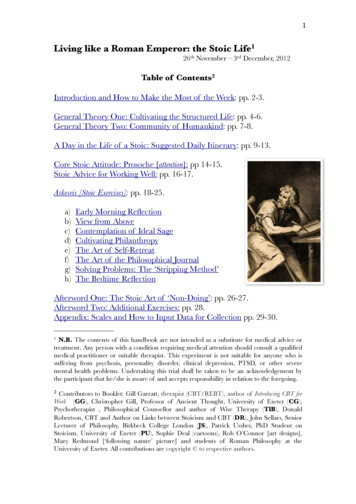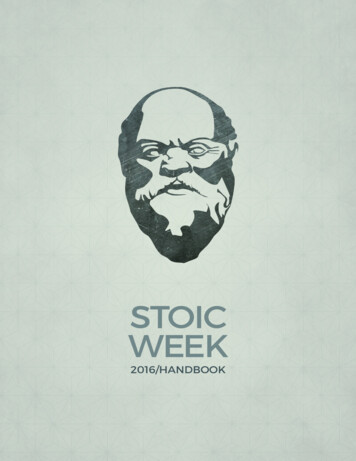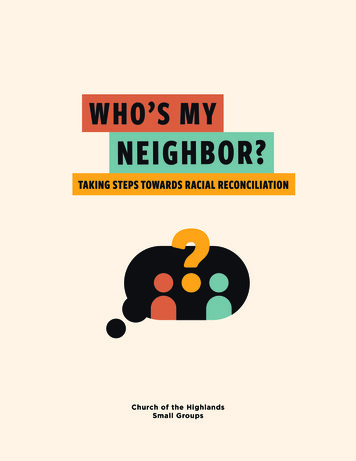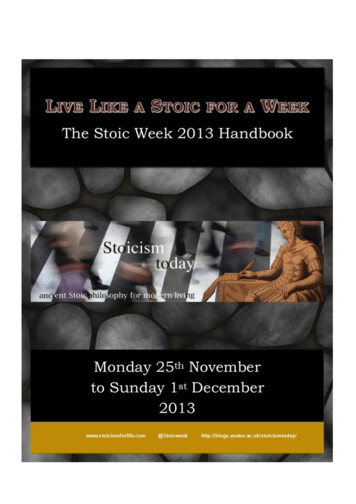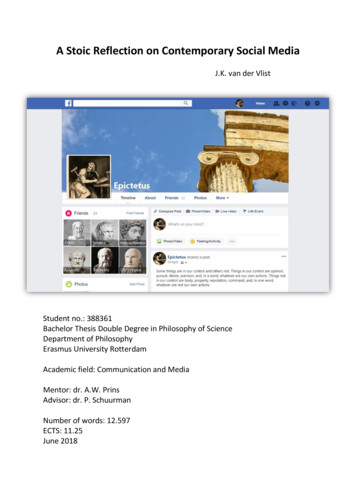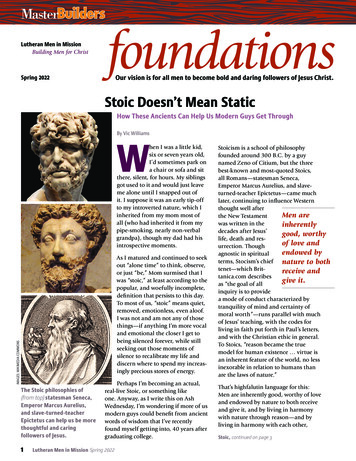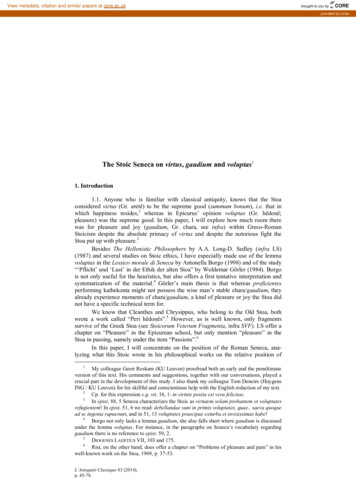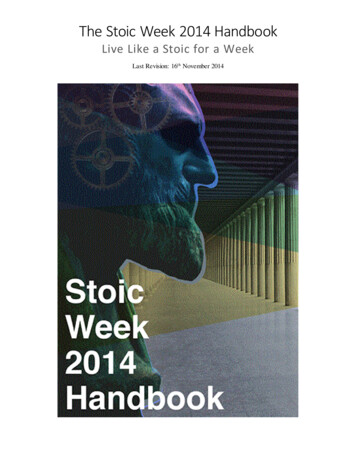
Transcription
The Stoic Week 2014 HandbookLive Like a Stoic for a WeekLast Revision: 16th November 2014
ContentsIntroductionWho Were the Stoics?Central Stoic IdeasStoic Maxims & AffirmationsStoic Week: Your Daily RoutineThe Stoic Self-Monitoring Record1.2.3.4.5.6.7.Monday: What is in our Power?Tuesday: Stoic MindfulnessWednesday: Self-Discipline & Stoic SimplicityThursday: Virtue and Relationships with OthersFriday: Action & The Stoic Reserve ClauseSaturday: Preparation for AdversitySunday: The View from AboveAfter Stoic WeekAppendices1. Meet the Team2. Further ReadingCopyright NoticeCopyright Christopher Gill, Patrick Ussher, John Sellars, Tim Lebon, Jules Evans, Gill Garratt, and Donald Robertson,2014. All rights reserved.Terms of useThe contents of this handbook are not intended as a substitute for medical advice or treatment. Any person with acondition requiring medical attention should consult a qualified medical practitioner or suitable therapist. This experimentis not suitable for anyone who is suffering from psychosis, personality disorder, clinical depression, PTSD, or other severemental health problems. Undertaking this trial shall be taken to be an acknowledgement by the participan t that they areaware of and accept responsibility in relation to the foregoing.
IntroductionWelcome to this opportunity to take part in a unique experiment: to follow the two millennia old Stoic Philosophy as aWay of Life in the modern day! This handbook stems from a project bringing together academics and psychotherapistswho want to explore the potential benefits of ancient Stoicism. In 2013, Stoic Week proved popular and was followed byover 2,400 people and we are now repeating the experiment the light of the feedback we gained from it and from ourfollow-up Stoic Mindfulness and Resilience Training (SMRT) elearning course, in which over 500 participants followed Stoicpractices for four weeks.In this handbook, you will find advice on how to adapt and follow Stoic principles, with a combination of general theoryand more specific, step-by-step guidance on certain Stoic exercises. These materials have been prepared by experts in thefield and give you an unusual, and free, chance for personal deve lopment.Q: How do I know that living like a Stoic will benefit me?A: You don’t. Indeed, one of the reasons we are conducting the experiment is to find out whether, and how, Stoic practicescan help us to live better lives. Having said that, in 2013, the findings showed that on average Life Satisfaction increasedby 14%, optimism by 18% and joy by 12%. Anger decreased by 13% and negativity by 12%. The Stoic Mindfulness andResilience Training (SMRT) course appeared to show that when we extended this from o ne week to four weeks, LifeSatisfaction increased by 27%, and negative emotions decreased by 23%.The benefit for you may also be educational, in understanding what Stoicism is about; it may be psychological, helpingyou become more resilient and possibly even happier; it may be moral, you may find that the week helps you developcertain desirable ethical qualities. You may even find that Stoicism as a philosophy just isn’t for you, which might in itselfbe a valuable thing to learn. However, most of the people who have participated in Stoic Week and related events havereported finding the experience very enjoyable and personally beneficial.Q: What’s the basic idea?A: This is what you need to do:1. Complete the online questionnaires at the beginning and end of Stoic Week.2. Follow the daily schedule, consisting of a passage for reflection and Stoic meditation morning and evening. Atlunchtime, or at another time that is good for you, consider the Stoic exercise for that day.The morning and evening meditation practices will provide you with a daily routine or structure to help you reflect onwhat happens each day. Guidelines for the Stoic meditations are offered in this booklet, but there are also guided audioexercises if you wish to use them. You can download these either from the Stoicism Today blog site or from the ModernStoicism elearning site.MP3 Audio Recordings on Stoicism TodayMP3 Audio Recordings on Modern StoicismYou’ll begin by learning to keep a record of your thoughts, actions, and feelings, and to start observing them in a moredetached and “philosophical” way. One of the main practical themes that runs through Stoicism, and therefore thisHandbook, is the strategy of distinguishing between things under your control and things that are not. The Stoics believedthis takes training to do well but that it’s the key to self-discipline and overcoming emotional disturbance. This requirescontinual attention to your own thoughts and judgements, which we can describe it as a kind of ‘mindfulness’ practice.You’ll then build upon this foundation by exploring different Stoic concepts and techniques each day, through the courseof the week.Q: I’m worried I may not have time to do everything. How can I give myself the best chance of making the most of it?
A: It will probably be helpful for you to think of this as a definite, short-term commitment – similar perhaps to the effortyou would put in to rehearsing the week before appearing in a play, or an exam, or training for a sporting event. Ideally,this might take about 15 minutes in the morning and evening, and the same at lunchtime, although you might want tospend more or less. If you can only spare five or ten minutes, that’s fine. This is similar to the commitment required formost research studies on psychological self-help or skills training.Q. How can I make use of modern technology whilst living like a Stoic?Here are some ideas: Record a video diary of your experiences of living like a StoicBlog about your experiences.Record your experiences on Facebook.Tweet about your experiences, or post Stoic adages on Twitter as you go along (#stoicweek).Each day summarise what you have learnt as a tweet.Use your phone to set reminders to start your Stoic practices.Make use of the online forums on modernstoicism.com or on the Facebook group.Which of these appeal to you? How many other ways can you use technology to help you live like a Stoic? If you are doingthe experiment with other people, it might help to discuss your experiences regularly. Perhaps you could have a 10 minuteStoic coffee each day where you touch base with others and discuss how you are doing.Q: How will I know whether it has helped or not?A: You will fill in questionnaires before and after the week which will help you to see objective measures of change andalso allow you to reflect on the experience. Your doing so will also help us to evaluate the benefits and limitations of Stoi cpractices. In Stoic terms, you could even say that participation in the experiment can be seen as contributing t o living agood life.Who Were the Stoics?Stoicism is an ancient Graeco-Roman philosophy. It was founded in Athens by Zeno of Citium around 301 BC. The namecomes from the painted porch or Stoa where he lectured to his students. Stoicism later became very popular in ancientRome, where it continued to flourish after the disappearance of the original Greek school. Less than one per cent of theoriginal writings of Stoicism now survive, however. The most significant ancient sources we have today are:1. The many letters, essays and dialogues of the Roman statesman Seneca, who was a committed Stoic, and alsoadvisor to the emperor Nero.2. Four lengthy collections of Discourses and one concise Handbook of sayings compiled from the lectures of a Greekex-slave called Epictetus by his student Arrian – Epictetus is the only Stoic teacher whose work survives in anysignificant quantity.3. The private Stoic notebook or diary, the Meditations, of the Roman emperor Marcus Aurelius, who was stronglyinfluenced by Epictetus.Much of the material in this handbook is drawn from the works of these three Roman Stoics, particularly Epictetus, whoseshort Handbook offers clear advice to someone who wants to live a Stoic life. In a sense, the handbook you’re currentlyreading is intended as a modern version of the ancient handbook of Epictetus, although we strongly encourage you toread the original as well as other classical texts, and modern commentaries, so that you can deepen your understandingof Stoic philosophy and practices.
Central Stoic IdeasWhat is Stoicism? How might it help us to live better, happier lives today? Some of you will be drawn to this experimentbecause you already know a little bit about Stoicism and want to put it into practice for yourselves. Others may know verylittle about Stoicism and are simply curious to learn more. The ancient philosophical system of Stoicism was well -knownfor being both large and complex, addressing a wide range of topics. So it will be impossible to introduce it all, but hereare three central ideas that are at the heart of Stoic ethical philosophy.1. ValueThe Stoics argued that the most important thing in life and the only thing with real value is ‘virtue’ or ‘excellence ofcharacter’. The core virtues for the Stoics were wisdom, moderation, courage, and justice. But Stoic virtue needs to beunderstood quite broadly, in terms of ethical principles as well as having a good character and good attitudes towardother people. Virtue is not just a matter of what’s going on in your he ad but also of what’s going in your family and socialrelations, your intentions, your actions, and your pattern of life as a whole.The central Stoic claim is that virtue is ultimately the only thing that really matters; it is the only thing that is truly goodand it is the only thing that can bring us well-being or happiness. Cultivating virtue, in terms of understanding, characterand our relationships, ought to be our top priority, above all other things, if we want to live a good, happy life.The Stoics also believe that, as human beings, we are naturally inclined to recognise the overriding value of virtue, andthat we have an inbuilt instinct to want to benefit others and to express this desire in social involvement and in coming tosee the bond between ourselves and all human beings.Conversely all those external things that people often pursue – a good job, money, success, fame, and so on – cannotguarantee us happiness, the Stoics claim. They could well be parts of a happy life but, on their own, they will never delivergenuine fulfilment, unless we also have the virtues.However this stress on the role of virtue does not mean that those things that people normally think of as good are notimportant – things such as health, having good friends, and financial means. It is just that our happiness depends ultimatelyon developing virtue rather than on having the opportunity to acquire these external things, which is always partly in thehands of fate.2. EmotionsIn the popular imagination a Stoic is someone who denies or represses their emotions in a potentially unhealthy way. Thisis a widespread misconception. The central Stoic claim is that our emotions are ultimately the product of judgements wemake. It is because we think external events are what ‘really matters’ that we feel anger or fear. As we get a betterunderstanding of what really matters, and what is ‘up to us’, then these unhealthy or irrational emotions will be replacedby healthy, rational ones. In short: as we develop ethically and as we see the absolute value of virtue, our emotional lifewill change for the better.In the same way that faulty judgements lead to irrational emotions or misguided desires, so too will wise judgements leadto well-grounded desires and emotions. For example, the Stoics claimed there were three broad categories of good desiresand emotions, which are part of a happy life and which naturally follow as a consequence of developing virtuous attitudes:1. Joy or delight, in the experience of what is truly good, as opposed to empty or irrational pleasures.2. Caution or discretion, directed at the prospect of what is truly bad, as opposed to irrational fear.3. Wishing or willing what is truly good, including the well-being of others and ourselves, as opposed to irrationalcraving for things that are not ‘up to us’ like health, wealth, or reputation.So the Stoic Sage is not a cold fish. In fact, the ancient Stoics repeatedly said their goal was not to be as unfeeling assomeone with a heart of stone or iron but rather to develop the natural affection we have for those close to us, in
accordance with virtue, ultimately extending our ethical concern to humankind in general, by developing an attitude ofphilanthropy.No school has more goodness and gentleness; none has more love for human beings, nor moreattention to the common good [than Stoicism]. The goal which it assigns to us is to be useful, to helpothers, and to take care, not only of ourselves, but of everyone in general and of each one inparticular. (Seneca, On Clemency, 3.3)The Stoics also acknowledge the existence of certain reflex-like aspects of emotion, physiological reactions, such asblushing, stammering, or being startled. These typically remain involuntary and beyond our direct control, although wecan choose how we respond to them and whether we allow ourselves to dwell on or escalate our first impressions andinitial reactions into full-blown “passions” of an excessive or unhealthy sort. It’s one thing to be startled or taken bysurprise, and another to continue needlessly dwelling on and worrying about unimportant things.3. Nature & the Community of HumankindOne of the most famous ancient Stoic slogans is that we ought to live in harmony with Nature. What did they mean bythis? The Stoics thought of Nature in at least three key ways.The Stoics think that leading a life with virtue as your goal is the natural way for a human being to live. The Stoics encourageus to see that if we create a wholeness and coherence of moral character in ourselves, we are matching the coherenceand unity that they see in the world as a whole.The Stoics also encourage us to see ourselves as integral parts of nature. Today, many human beings are aware that theyneed to think more about the impact of human actions on the natural environment and to see themselves within thecontext of nature and the Stoic world-view can help us develop this attitude.For the Stoics, our life-cycle, birth and death, are integral parts of our life in nature, and realising this can help us acce ptthese events, including our own death and that of others.As noted already, virtue is not just a matter of your state of mind but of how you relate to other people. The Stoics believethat most species of animals, and especially the human species, are naturally sociable in character. We naturally formattachments and we naturally live in communities. From this natural affection stems the Stoic ideal of the ‘community ofhumankind’. As Marcus Aurelius writes:We were born for cooperation, like feet, like hands, like eyelids, like the rows of upper and lowerteeth. So to work in opposition to one another is against nature: and anger or rejection is opposition.(Meditations, 2.1)Taking PartIf you are going to follow Stoic Week then you need to be open to these three central ideas. You don’t need to acceptthem uncritically, but you do at least need to be prepared to explore them further and consider whether they seem toyou actually true as well as potentially beneficial to you in how you lead your life.Our aim in this project is not to try to convince you of the truth of these claims but simply to see if they are helpful for youin the way you lead your life. If these three central ideas seem completely absurd to you then it may be that Stoic Weekis not the right experiment for you.
Stoic Maxims & AffirmationsThe Stoics appear to have repeated certain key phrases or maxims to themselves in order to memorise them and havethem constantly “ready-to-hand”, especially in the face of a crisis. Epictetus tells his students to repeat various statementsto themselves mentally. Some of these are of a general nature, whereas others are things Stoics were told to say inresponse to specific emotional challenges. For instance, “You are just an impression and not at all the thing you claim torepresent” and “This is nothing to me”, in response to troubling thoughts, or “It seemed right to him” when someone actsin a way that might be upsetting or objectionable.The Stoic literature is full of brief “Laconic” phrases, memorable sayings that are eminently quotable but also helped Stoicsto commit key philosophical ideas to memory as a way of coping with adverse circumstances. When someone complainedto Zeno, the founder of Stoicism, that these philosophical sayings were too condensed, he replied that they were supposedto be concise and that if he could he’d abbreviate the sound of the syllables as well!Having these thoughts always at hand, and engrossing yourself in them when you are by yourself,and making them ready for use, you will never need any one to comfort and strengthen you.(Epictetus, Discourses, 3.24).Example Self-StatementsHere are some examples of typical Stoic sayings, derived from the classical literature. In some cases they’ve been modifiedvery slightly to make them more suitable for use as affirmations. When you repeat them, try to contemplate their meaningor, if you prefer, imagine that you’re rehearsing what it would be like to really accept them and believe in these principlescompletely.From the Handbook of Epictetus “Some things are under my control and other things are not.”“People are upset not by things but by their judgements about things.”“You are just an appearance and not at all the thing you claim to represent.”(Response to a troubling impression.)“You are nothing to me.”(Response to things not under your control.)“Virtue is the only true good.”“What is beyond my control is indifferent to me.”“If you want any good, get it from within yourself.”“Don’t demand that things go as you will, but will that they happen as they do, and your life will go smoothly.”“Sickness is a hindrance to the body, but not to the will.”“Never say of anything ‘I have lost it’ but ‘I have returned it.’”“It seemed right to them.” (Response to someone whose actions seem disagreeable to you.)“Everything has two handles, and can be picked up and carried either wisely or foolishly.”“Whoever yields properly to Fate, is deemed wise among men, and knows the laws of heaven.” (Quoted fromEuripides)These two famous sayings were also associated with Epictetus’ brand of Stoicism: “Remember thou must die.”“Endure and renounce” or “bear and forbear”, having the virtues of courage and self -discipline.Some more suggestions from the Stoic community:
“Remember too on every occasion which leads thee to the present difficulty to apply this principle: not that thisis a misfortune, but that to bear it nobly is good fortune.” (Meditations, 4.49)“The thing that matters the most is not what you bear but how you bear it.” (Seneca, On Providence)“Begin at once to live, and count each separate day as a separate life.” (Seneca)“If I knew that it was fated for me to be sick, I would even wish for it; for the foot also, if it had intelligence,would volunteer to get muddy.” (Chrysippus)Audio Download: Stoic Attitudes MeditationYou may also want to listen to the MP3 audio recording we created called the Stoic Attitudes Meditation. This contains acontemplative exercise consisting of a scripted series of philosophical affirmations, closely-based on the Stoic literature.You can download this along with the other exercises via the links in the Introduction to this Handbook.
Stoic Week: Your Daily RoutineEach day in Stoic Week has its own central theme. These will build upon one another as the week progresses. This willmake the whole week the beginning of a journey into Stoicism. Take some time out at lunchtime each day, or any timethat suits you, to reflect on the day’s theme and think about how it might shape the various activities in which you areengaged.There are also morning and evening meditations to practise, which you should try, if possible, to practise at the beginningand end of each day. Let’s now explore these two practices in more detail.Early-Morning MeditationWhen you wake up each morning, take a few moments to compose yourself and then patiently rehearse the day ahead,planning how you can make yourself a better person, while also accepting that some things lie beyond your control.1. Marcus Aurelius talks about walking on your own to a quiet place at daybreak and meditating upon the stars andthe rising Sun, preparing for the day ahead. You can also do this at home, sitting on the end of your bed, or standingin front of the mirror in your bathroom, and still think of the sun rising against a backdrop of stars.2. Pick a specific philosophical principle that you want to rehearse and repeat it to yourself a few times beforeimagining how you could put it into practice during the rest of the day. You might choose the key general Stoictheme: ‘Some things are under our control whereas others are not’, and to think about giving more importanceto being a good person and acting well and treating things you cannot control as ultimately much less important.3. Alternatively, you might pick a specific virtue that you want to cultivate and prepare yourself mentally for yourday ahead, in broad outline, imagining how you would act if you showed more wisdom, justice, courage, ormoderation.4. Practise this meditation for about 5-10 minutes, picking out key events or specific challenges that might arise.Once you’ve got into the habit of doing this, try imagining greater challenges in the day ahead such as some of your plansnot going as you hope and dealing with difficult people. As you consider a possible difficulty, think about how you couldtackle it with a Stoic principle or virtue.Say to yourself at daybreak: I shall come across the meddling busy-body, the ungrateful, theoverbearing, the treacherous, the envious, and the antisocial. All this has befallen them because theycannot tell good from evil. (Meditations, 2.1)Late-Evening MeditationEpictetus and Seneca both allude to the use within Stoicism of a form of contemplative, philosophical self -analysis,practised regularly, each evening, which was borrowed from Pythagoreanism. For example, Epictetus quoted the followingpassage from the Golden Verses of Pythagoras to his students:“Allow not sleep to close your wearied eyes,Until you have reckoned up each daytime deed:‘Where did I go wrong? What did I do? And what duty’s left undone?’From first to last review your acts and thenReprove yourself for wretched [or cowardly] acts, but rejoice in those done well.” (Discourses 3.10.2–3)For our purposes, at night, before going to sleep, take 5-10 minutes to review the events of your day, picturing them inyour mind if possible. It’s best if you can do this before actually getting into bed, where you might begin to feel drowsyrather than thinking clearly. You may find it helpful to write notes on your reflections and self -analysis in a journal,documenting your ‘journey’ as you learn to apply Stoic practices in daily life. Try to remember the order in which you
encountered different people throughout the day, the tasks you engaged in, what you said and did, and so on. Ask yourselfthe following questions (or questions similar to these):1. What did you do badly? Did you allow yourself to be ruled by fears or desire of an excessive or irrational kind? Didyou act badly or allow yourself to indulge in irrational thoughts?2. What did you do well? Did you make progress by strengthening your grasp of the virtues?3. What did you omit? Did you overlook any opportunities to exercise virtue or strength of character?4. Consider how anything done badly or neglected could be done differently in the future - do this by criticising yourspecific actions rather than yourself as a person in general.5. Praise yourself for anything done well.In doing this, as Seneca put it, you are adopting the role of a friend and wise advisor toward yourself, rather than a harshor punitive critic.We can probably assume that a Stoic whose self-analysis and review of the preceding day leads him to conclude he haserred in his judgement, acted badly, or failed to follow his principles, would seek to learn from this and act differently thefollowing day. Waking up the next day, you’ll probably find it natural to base your morning meditation, in part, on yourreflections before going to sleep the previous night. These meditations can combine to form a ‘learning cycle’, as you planhow to live and act more wisely, put this into practice during the day, and then reflect on the outcome afterwards, whichleads to the same cycle the following day.The advice from modern psychotherapy would be that you’ll need to be cautious to avoid reflection turning into morbid‘rumination’. Don’t dwell too long on things or go around in circles. Rather, try to keep a practical focus and arrive at cleardecisions if possible; if not, then set your thoughts aside to return to them in the morning. There are many hidden aspectsto this exercise, which will become clearer as you progress in your studies of Stoicism. For example, bearing in mind thatthe past is beyond your ability to control, you might want to use this review to adopt an attitude of provisional acceptanceof your own failings, forgiving yourself while resolving to behave differently in the future. Hence, as Seneca emphasises,when describing his use of the same evening routine, we should not be afraid of contemplating our mistakes because asStoics we can say: “Beware of doing that again - and this time I pardon you.”Audio Download: Morning and Evening MeditationsAudio exercises for Stoic Week 2014, including the morning and evening meditation, can be found via the links in theIntroduction chapter of this Handbook.
The Stoic Self-Monitoring RecordYou may find it helpful, if you so choose, to make use of a self-monitoring record. This will help you keep a record of thingsyou’d like to stop, such as dwelling on negative thoughts and things you might later regret. If you feel you’ve not got timeto do this, don’t worry it’s optional, but if you are able to make the time, we’re sure you’ll find it contributes significantlyto the benefits you derive from Stoic Week.The self-monitoring record is based on methods used in cognitive -behavioural therapy (CBT). However, although theancient Stoics didn’t actually fill out a form like this, we can find similar self -monitoring practices recommended in theirwritings. The record we suggest you keep is just a simple sheet of paper with several columns marked on it as below. Youcan make your own version or you can find a version we have created in the appendices.This process is about taking a step back from things, and gaining what therapists call ‘psychological distance’ from yourinitial, upsetting thoughts and feelings. Become a detached observer of yourself for a while. Write things down as soon aspossible, as doing so will help you view things in this detached way, observing events and describing them in an objectivemanner.1. Date/TimeNote the date and time of the event, when you started to feel angry or afraid, for example, and briefly describe the actualsituation you were facing, e.g., perhaps someone criticised your work, or maybe someone offered you some junk foodwhile you were trying to lead a healthy life.2. FeelingsWhat emotions or desires did you actually experience (the Stoics use the technical term ‘passions’ for both). Remember,we’re only really interested in feelings that might be considered irrational in the sense of being misguided and negative.So, following on from our examples above, you might write down that you felt excessively anxious or angry about beingcriticised, or that you felt a strong craving to eat junk food, which you found hard to resist. Remember that you’re alsotrying to catch these feelings early, so try to note ‘early-warning signs’, which are often sensations such as trembling whenafraid, although sometimes they might be thoughts such as telling yourself ‘just one won’t hurt’ when you’re tempted toeat something unhealthy.3. ThoughtsWhat related thoughts went through your mind? Stoic psychology held that our emotions and desires fundamentallydepend upon our thoughts, particularly our value-judgements. Be forewarned that most people find it difficult at first toidentify the specific thoughts that are responsible for their feelings. You’ll probably need to work on this, but with practice,and study, it should become easier. Were you telling yourself that something external is very good (desirable) or bad(upsetting)? For example, someone who feels anxious and angry about being criticised might come to realise that they’rethinking ‘I must be respected at work’ and placing great importance or intrinsic value on other people’s opinions of them,instead of wanting to do their job well for its own sake.4. ControlAs we’ll see, this is the central question that Stoics use to evaluate their impressions: ‘Is it up to me?’. They meant ‘Is t his- the thing that my feelings are about – under my direct control?’ Again, don’t worry too much about this for your first dayor so, because as you learn more about Stoicism you’ll get better at posing this question. For example, you might observethat other people’s opinions of you, and whether or not they criticise you, is ultimately beyond your direct control – allyou can control in this situation is your current response to their words and perhaps your plans for how to act the future.Even your past failings are no longer within your power to change – you can’t rewrite the past.
This distinction between what is up to us and what is not is crucial for Stoics, as you’ll see, because they urge us to acceptthose things in life we cannot possibly change, while seeking to change the
detached and philosophical _ way. One of the main practical themes that runs through Stoicism, and therefore this Handbook, is the strategy of distinguishing between things under your control and things that are not. The Stoics believed this takes training to do well but that its the key to self-discipline and overcoming emotional disturbance.


